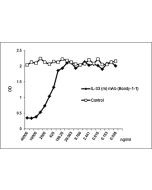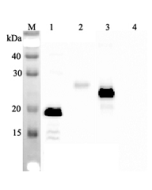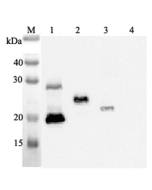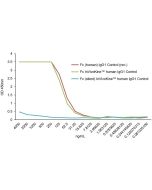Cookie Policy: This site uses cookies to improve your experience. You can find out more about our use of cookies in our Privacy Policy. By continuing to browse this site you agree to our use of cookies.
AdipoGen Life Sciences
IL-33 (oxidation resistant) (human) (monomer):Fc InVivoKine™

| Product Details | |
|---|---|
| Synonyms | IL-33 (human) (C208S/C232S Mutant):Fc KIH (human) (rec.); Interleukin-33 (human) (C208S/C232S Mutant); IL-1F11; NF-HEV |
| Product Type | Protein |
| Properties | |
| Source/Host | HEK 293 cells. Produced using animal component-free medium. |
| Sequence |
Human IL-33 (aa 112-270) (with mutations C208S and C232S to protect IL-33 from oxidation) is fused at the C-terminus to the Fc portion of human IgG1 (Knobs-into-Holes technology) (see reference: J.B. Ridgway, et al.; Protein Eng. 9, 617 (1996)). |
| Crossreactivity |
Human Mouse |
| Specificity |
Binds to human and mouse ST2. |
| MW | ~55kDa and 28 kDa (SDS-PAGE) |
| Purity | ≥95% (SDS-PAGE) |
| Endotoxin Content | <0.01EU/μg purified protein (LAL test). |
| Concentration | After reconstitution: 1mg/ml |
| Reconstitution | Reconstitute with 50μl sterile water. |
| Formulation | Lyophilized. Contains PBS |
| Protein Negative Control | |
| Other Product Data |
UniProt link Q2YEJ5: Interleukin-33 (human) |
| Shipping and Handling | |
| Shipping | BLUE ICE |
| Short Term Storage | +4°C |
| Long Term Storage | -20°C |
| Handling Advice |
After reconstitution, prepare aliquots and store at -20°C. Avoid freeze/thaw cycles. Centrifuge lyophilized vial before opening and reconstitution. PBS containing at least 0.1% BSA should be used for further dilutions. |
| Use/Stability |
Stable for at least 6 months after receipt when stored at -20°C. Working aliquots are stable for up to 3 months when stored at -20°C. |
| Documents | |
| MSDS |
 Download PDF Download PDF |
| Product Specification Sheet | |
| Datasheet |
 Download PDF Download PDF |
Interleukin-33 (IL-33; HF-NEV; IL-1F11), a member of the IL-1 family of cytokines, is expressed by many cell types following pro-inflammatory stimulation and is thought to be released upon cell lysis. IL-33 binds to and signals through ST2 (IL-1R1) and its stimulation recruits MYD88, IRAK, IRAK4 and TRAF6, followed by phosphorylation of ERK1 (MAPK3) / ERK2 (MAPK1), p38 (MAPK14) and JNK. The ability of IL-33 to target numerous immune cell types, like Th2-like cells, mast cells and B1 cells, and to induce cytokine and chemokine production underlines its potential in influencing the outcome of a wide range of diseases, such as arthritis, asthma, atopic allergy & anaphylaxis, cardiovascular disease/atherosclerosis, nervous system diseases and sepsis. IL-33 facilitates Treg expansion in vitro and in vivo. Recently, IL-33 has been involved in adipocyte differentiation. The biological activity of IL-33 at its receptor ST2 is rapidly terminated in the extracellular environment by its oxidation (formation of two disulfide bridges), resulting in an extensive conformational change that disrupts the ST2 binding site. Mutations at amino acids C208S/C232S protect IL-33 from oxidation and increase its activity.
The IL-33 (oxidation resistant) (human) (monomer):Fc InVivoKine™ is produced by using two different vectors, one encoding for the IL-33 (human) (oxidation resistant):Fc Knobs sequence (synthesizing a protein of 55kDa) and one encoding for the Fc Holes sequence (synthesizing a protein of 28kDa). Both vectors transfected into HEK293 cells produce both Fc molecules (Knobs-into-Holes technology; J.B. Ridgway, et al.; Protein Eng. 9, 617 (1996)) required for dimerization and for secretion of the final protein IL-33 (oxidation resistant) (human) (monomer):Fc InVivoKine™.
InVivoKines™ are a new generation of recombinant fusion proteins for immunotherapeutic, preclinical and translational in vivo research, developed and manufactured by AdipoGen Life Sciences.












